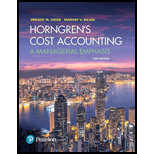
Concept explainers
Variances in the service sector. Derek Wilson operates Clean Ride Enterprises, an auto detailing company with 20 employees. Jamal Jackson has recently been hired by Wilson as a controller. Clean Ride’s previous accountant had done very little in the area of
Jackson examines past accounting records, and establishes some standards for the price and quantity of labor. While Clean Ride’s employees earn a range of hourly wages, they fall into two general categories: skilled labor, with an average wage of $20 per hour, and unskilled labor, with an average wage of $10 per hour. One standard 5-hour detailing job typically requires a combination of 3 skilled hours and 2 unskilled hours.
Actual data from last month, when 600 detailing jobs were completed, are as follows:
| Skilled (2,006 hours) | $39,117 |
| Unskilled (944 hours) | 9,292 |
| Total actual direct labor cost | $ 48,409 |
Looking over last month’s data. Jackson determines that Clean Ride’s labor price variance was $1,151 favorable, but the labor efficiency variance was $1,560 unfavorable. When Jackson presents his findings to Wilson, the latter is furious. “Do you mean to tell me that my employees wasted $1,560 worth of time last month? I’ve had enough. They had better shape up, or else!” Jackson tries to calm him down, saying that in this case the efficiency variance doesn’t necessarily mean that employees were wasting time. Jackson tells him that he is going to perform a more detailed analysis, and will get back to him with more information soon.
- 1. What is the budgeted cost of direct labor for 600 detailing jobs?
- 2. How were the $1,151 favorable price variance and the $1,560 unfavorable labor efficiency variance calculated? What was the company’s flexible-
budget variance ? - 3. What do you think Jackson meant when said that “in this case the efficiency variance doesn’t necessarily mean that employees were wasting time”?
- 4. For the 600 detailing jobs performed last month, what is the actual direct labor input mix percentage? What was the standard mix for labor?
- 5. Calculate the total direct labor mix and yield variances.
- 6. How could these variances be interpreted? Did the employees waste time? Upon further investigation, you discover that there were some unfilled vacancies last month in the unskilled labor positions that have recently been filled. How will this new information likely impact the variances going forward?
Want to see the full answer?
Check out a sample textbook solution
Chapter 7 Solutions
Horngren's Cost Accounting, Student Value Edition Plus MyLab Accounting with Pearson eText - Access Card Package (16th Edition)
- ayco Inc. started its operations in 2022. Its sales during 2022, all on account, totalled $700,000. The company collected $500,000 in cash from customers during the year and wrote off $8,000 in uncollectible accounts. The company set up an allowance for doubtful accounts at December 31, 2022, its fiscal year-end, and determined the account balance to be $14,000. The unadjusted balances of selected accounts at December 31, 2023 are as follows: Accounts receivable $ 300,000 Allowance for doubtful accounts (debit) 10,000 Sales revenue (including 80 percent in sales on account) 800,000 Aging of the accounts receivable on December 31, 2023, resulted in an estimate of $11,000 in potentially uncollectible accounts. Required: 1. Prepare the journal entries to record all the transactions during 2022 and post them to appropriate T-accounts. (If no entry is required for a transaction/event, select "No journal entry required" in the first account field.)…arrow_forwardCalculate the sample size based on the specifications in Buhi's contract. Make sure it is within budget, reasonable to obtain, and that you use appropriate inputs relative to market research best practices. Use the calculator to adjust the sample size statement. Use the agreed-upon sample size in Buhi's contract: 996. In your secondary research, find the target population size (an estimate of those in the United States looking to purchase luggage in the category in the next two years). You will use this target population size for each sample size estimate. Adjust the provided sample size calculator inputs to find the rest of the figures that get you to the agreed-upon sample size. The caveats from Buhi are that you must: Use the market research standard for your confidence level. Use a confidence interval that is better than the market research standard for your confidence interval.arrow_forwardThe partnership of Keenan and Kludlow paid the following wages during this year: Line Item Description Amount M. Keenan (partner) $108,000 S. Kludlow (partner) 96,000 N. Perry (supervisor) 54,700 T. Lee (factory worker) 35,100 R. Rolf (factory worker) 27,200 D. Broch (factory worker) 6,300 S. Ruiz (bookkeeper) 26,000 C. Rudolph (maintenance) 5,200 In addition, the partnership owed $250 to Rudolph for work he performed during December. However, payment for this work will not be made until January of the following year. The state unemployment tax rate for the company is 2.95% on the first $9,000 of each employee's earnings. Compute the following: ound your answers to the nearest cent. a. Net FUTA tax for the partnership for this year b. SUTA tax for this yeararrow_forward
 Cornerstones of Cost Management (Cornerstones Ser...AccountingISBN:9781305970663Author:Don R. Hansen, Maryanne M. MowenPublisher:Cengage Learning
Cornerstones of Cost Management (Cornerstones Ser...AccountingISBN:9781305970663Author:Don R. Hansen, Maryanne M. MowenPublisher:Cengage Learning
